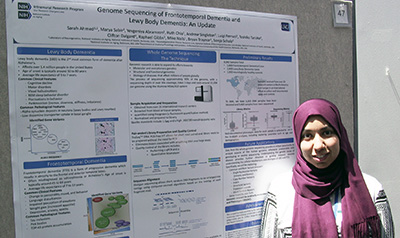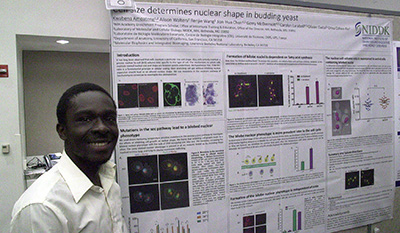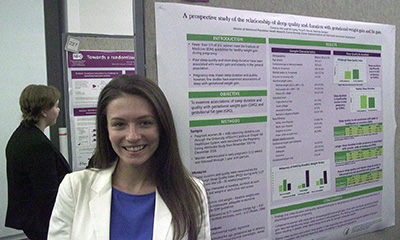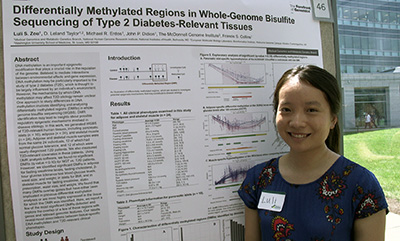Postbac Poster Day Highlights Budding Researchers
On Wednesday, May 2, hundreds of researchers gathered at NIH’s Natcher Conference Center to show off their recent discoveries. But unlike a typical scientific conference, the letters “M.D.” and “Ph.D.” were noticeably absent from these scientists’ credentials. Instead, the event — NIH’s annual Postbac Poster Day — celebrated the accomplishments of individuals participating in the NIH Postbaccalaureate Intramural Research Training Award (IRTA) Program.
Typically called ‘IRTAs’ (pronounced ‘er-tahs’) by the NIH community, all of the programs’ participants recently completed their undergraduate studies and have spent the past year performing research in IRP laboratories all across the NIH. Read on to get to know a handful of these promising future scientists and clinicians.
Sarah Ahmed: Pursuing Parkinson’s Genes

Sarah’s research group is trying to unravel how genes contribute to the development of neurodegenerative diseases like Parkinson’s disease and multiple sclerosis. Because her work mixes genetics and neuroscience, she collaborates with a large number of researchers specializing in different disciplines.
"My lab currently has over 60 people in it, and I’m really blessed to be able to work with many different people who have a broad range of specialties,” she says. “I’ve seen a lot of different techniques that I would not have been exposed to in a smaller lab. And the mentorship opportunities I’ve had here have been incredible; my PI has worked with me and other postbacs in my lab one on one to try to make sure that everything we’re doing in the lab really has a purpose and will help us in the long run.”
Kwabena Amoateng: Scrutinizing Cellular Structure

Kwabena’s research focused on how the structure of a cell’s nucleus affects the cell’s behavior. His work, which he performs in yeast cells, could help advance our understanding of conditions like aging and cancer that are related to structural changes in cells.
“I have my degree in biological sciences, and I wasn’t thinking of cancer research — I wanted to do more public health,” he says. “But since I started working on this project, I’m actually thinking of maybe going to medical school and exploring cancer more.”
Christine Hill: Sussing Out the Effects of Sleep on Pregnant Women’s Weights

Christine has been examining the association between the quality and duration of a pregnant woman’s sleep and the amount of weight and fat she gains during her pregnancy. Christine’s analysis showed that women who sleep less and have lower-quality sleep late in their pregnancies gain more fat than those who get more and better-quality sleep.
“Being at NIH has been an amazing experience,” she says. “Coming from undergrad, I’ve been able to learn so much about research and get so much real experience in a work place. NIH has also been so supportive with so many resources to help me move on to my next step in graduate school, which I’ll be starting in August.”
Chelesa Fearce: Delving Into Dopamine Drugs

Chelesa spent the past year scrutinizing the behavior of dopamine receptors in the hopes of aiding the development of better drugs for psychiatric disorders like schizophrenia in which dopamine is thought to play a role. She screened a multitude of compounds to determine relationships between their structures and their ability to influence the activity of dopamine receptors.
“Being at NIH has been wonderful,” she says. “I love it. I’m interested in M.D.-Ph.D. programs, so research is very important to me. This is my first experience in pharmacology, and it’s helped me understand that I really do want to do this as a research career.”
Ryan Beckner: Picking Apart a Pain-Relieving Receptor

Ryan’s lab is working towards a better model system for investigating the type II human cannabinoid receptor, which plays a role in bodily inflammation and pain relief.
“My experience at NIH has been great,” he says. “It’s been a very good mix of independent research and being able to design and pursue your own projects while also having a lot of very good mentoring and direction at the same time.”
Luli Zou: Investigating the Influence of Environmental Factors in Diabetes

Luli works in the lab of NIH Director Francis Collins, M.D., where her project aims to elucidate the role of environmental influences on the development of type 2 diabetes. She has specifically been analyzing patterns of DNA methylation, chemical tags on genes that are thought to be “sort of a mediator between environmental factors that you experience day-to-day and gene expression levels,” she explains.
“I’ve been pretty lucky to have a lab where it seems like we have a lot of data and not enough time to analyze it,” she says. “This methylation data that I’ve been working on is just one example of the amazing types of sequencing data that we’re able to get nowadays, and it’s just been awesome to dig into it and see what types of methods I can apply and come up with to analyze the differences.”
Thanks to the Postbac IRTA program, these six budding scientists and their hundreds of fellow IRTAs will depart the NIH with a crucial understanding of the day-to-day realities of scientific inquiry. Whether they end up pursuing research, medicine, or a career outside the life sciences, their experience at NIH will surely be a boon to their futures.
To learn more about how the IRP is helping to launch the next generation of researchers and clinicians, read one former IRTA’s reflection on her time in the program and check out the Summertime Brains video series.
Subscribe to our weekly newsletter to stay up-to-date on the latest breakthroughs in the NIH Intramural Research Program.
Related Blog Posts
This page was last updated on Wednesday, July 5, 2023
